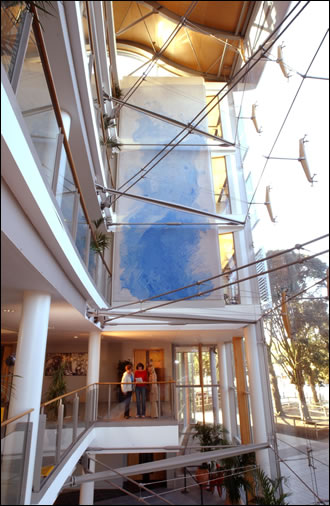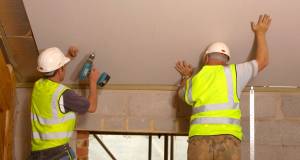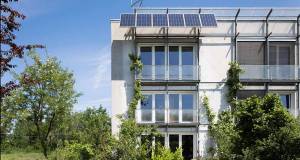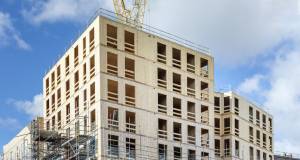- Local Authorities
- Posted
Fingal Commits
This article was originally published in issue 12, Vol 2 of Construct Ireland magazine.
In October 2005 Fingal County Council brought out sustainable building requirements of an unprecedented nature in Ireland, a landmark decision which should prove highly influential in progressing the shift to energy efficient, healthy, low environmental impact buildings in Ireland. The Local Area Plan for the Cappagh region of Fingal includes a range of sustainable building requirements, with perhaps the most notable being that the annual space and water heating energy requirements for all buildings must now not exceed 50 kWh/m2, and that renewable energy must be used to meet at least 30% of these energy needs. In December the council consolidated their commitment to sustainable building, with councillors voting through the same requirements into Local Area Plans for North Ballymun and Northwest Balbriggan. In this forward thinking policy, which will positively impact on the design and construction of thousands of buildings in Fingal, local authorities across Ireland have a template to bring in similar requirements into both County Development Plans and Local Area Plans, with benefits almost too numerous to take in. But how did such a groundbreaking approach come to fruition?
The initial attempt to implement these laudable requirements can be traced back to February 2005, when Fingal’s Green Party Councillors for Howth, Balbriggan and Malahide—David Healy, Joe Corr and Robbie Kelly respectively—submitted sustainable building requirement proposals they had been developing for the County Development Plan.
“We wanted to get a standard into the County Development Plan that all developments would have to meet”, explains David Healy. “We drafted it up with the double requirement of a heating demand and a percentage of renewable energy”.
However, although the proposals were given detailed consideration at the time, there was some scepticism in the council about setting sustainable building requirements of this kind and on this scale. “At that stage the planners argued that this wasn't something that should go into the County Development Plan; that it was a matter for the Building Regulations. From looking at the 2000 Planning and Development Act it’s clear that we can include these kinds of standards in the Development Plan, but the majority of the councillors decided not to. It was quite a close decision,” Healy reveals.
A key concern which the council were understandably affected by was how the market would respond to bringing in requirements of this kind. Crucially, in the aftermath of the vote on the County Development Plan, Healy, Corr and Kelly did not lose faith in their approach, and an opportunity arose in discussions with Menolly Homes, who were looking to develop land in Barnhill, Dublin 15.
“We got a number of commitments from the land owner. One was in relation to public transport access to the site, and the other in relation to the energy standards that we were looking for”, states Healy. “On that basis it was made a public commitment and we wrote it in at zoning. I think that probably changed the views of some of the councillors, in that a developer had shown that these were reachable standards and could be achieved”.
Armed with proof that developers were prepared to meet sustainable building requirements above and beyond Building Regulations requirements, the councillors submitted the following proposals into the Local Area Plan for Cappagh, which were successfully voted through in October 2005:
“The residential development will attain high standards of energy efficiency and environmental sustainability, including the following:
- bio-climatic site design,
- water conservation,
- ventilation,
- energy efficient strategies for housing design,
- daylight analysis,
- high insulation standards
“All new buildings will meet the minimum low energy performance standards(as defined below) as a prerequisite to receiving planning approval (calculation report to be submitted with the planning application). Each building's energy performance calculation must be demonstrated on the basis of a simple approved method (e.g. EN 832) carried out by qualified or accredited experts. Low energy buildings are defined as building with an annual heating requirement (space and water heating) not exceeding 50
kWh/m2 of useful floor area.
The development will utilise renewable energy supply systems to meet at least 30% of the buildings space and water heating requirements as calculated on the basis of an approved method carried out by qualified or accredited experts.”
These requirements, which have subsequently been incorporated into Local Area Plans for North Ballymun and Northwest Balbriggan break new ground not only in terms of setting sustainable building regulations, but also through the use of the Planning and Development Act 2000 as a means of justifying exceeding Building Regulations requirements by some distance. Section 19 of the Act stresses that Local Area Plans can include objectives set “by the planning authority for the proper planning and sustainable development of the area to which it applies, including detail on […] standards for the design of developments and structures”. The Act also gives power to local authorities in terms of “regulating and controlling the design, colour and materials of structures and groups of structures, including streets and townscapes, and structures and groups of structures in rural areas”, and crucially, in terms of “promoting design in structures for the purposes of flexible and sustainable use, including conservation of energy and resources”.
This text from the Act certainly appears to support local authorities looking to set specific sustainable building requirements, but does it hold true? Conor Linehan, of leading law firm William Fry Solicitors’ Environmental and Planning Unit, lends his opinion.

View from the first floor of Bucholz McEvoy's Fingal Civic Offices, which were lauded for their energy efficiency and design
“The Planning and Development Act 2000 obliges planning authorities to have regard to sustainable development when planning for local areas through formal Local Area Plans”, Linehan explains. “The Act also affords a wide scope to planning authorities as regards the means and the detail for delivery of sustainable development, through Local Area Plans. The requirements regarding energy efficiency standards for buildings in Cappagh, North Ballymun and Northwest Balbriggan reflect that wide discretion”.
View on Fingal “The Planning and Development Act 2000 obliges planning authorities to have regard to sustainable development when planning for local areas through formal Local Area Plans. The Act also affords a wide scope to planning authorities as regards the means and the detail for delivery of sustainable development, through Local Area Plans. The requirements regarding energy efficiency standards for buildings in Cappagh, North Ballymun and Northwest Balbriggan reflect that wide discretion”.
“The Planning and Development Act 2000 obliges planning authorities to have regard to sustainable development when planning for local areas through formal Local Area Plans. The Act also affords a wide scope to planning authorities as regards the means and the detail for delivery of sustainable development, through Local Area Plans. The requirements regarding energy efficiency standards for buildings in Cappagh, North Ballymun and Northwest Balbriggan reflect that wide discretion”.
- Conor Linehan, Environmental and Planning Unit, William Fry Solicitors
This point is supported by Cadogan Enright, Programme Manager for Sustainable Development Ltd., an NGO campaigning on building standards, renewable energy and sustainable use of water, who played a key role in helping the Green Party councillors to develop the sustainable building requirements for Fingal. Enright sought legal advice on the requirements, “to make sure that they couldn’t be overturned, by appeal to an Bord Pleanála. The only grounds for appeal, it turns out, is if it wasn’t practically possible to build to these standards; if the suppliers didn’t exist. The legal advice we got essentially said that so long as suppliers existed, and it was a practical proposal, it couldn’t be overturned by an Bord Pleanála”, stresses Enright. “On this basis we checked with Sustainable Energy Ireland’s Renewable Energy Information Office in Cork, and they have a pack which refers people to suppliers who can meet these standards, and we also checked with substantial companies like Century Homes, who have confirmed that they can also meet these standards. So clearly, the ability to deliver into the market for even very large builders is there in Ireland.
“We are interested in helping any organisation of influence. In the past we have also helped Fine Gael on energy policy. So clearly, helping the Green Party devise standards that are both feasible and practical was an obvious thing for us to do”.
Enright also draws confidence in the market’s ability to respond to requirements of this nature based on the many examples in Ireland and Europe of buildings which far exceed the requirements set by Fingal County Council. “We know from our experience that it is possible”, Enright asserts. “People are even building passive houses, with a heating consumption of 15KwHr/m2 in this country, and they have even higher standards in Germany , for example. At the moment our company is looking at a two acre site in Donabate where we want to build to the Plus House standard, where houses actually produce a surplus of energy for their occupants throughout the year”.
Properties built under the sustainable building requirements in the three Local Area Plans are bound to prove an attractive investment in a rapidly changing property market, where poorly conceived and executed buildings are destined to become a liability, exposed to exponentially rising oil and gas prices, the imminent introduction of energy ratings for buildings and the ever approaching Kyoto CO2 emissions reduction deadline. Sustainable buildings and sustainably planned developments on the other hand, are only becoming more viable, as David Healy stresses. “This is a major selling point in all such developments in other countries. If you look at the likes of Bedzed in London, they are now places with long waiting lists that cost more than other houses in the area. The market is definitely there in other European countries. There is no reason why it shouldn't be here.
View on Fingal The Minister for the Environment, Heritage and Local Government, Mr. Dick Roche, T.D., is impressed by the Local Area Plan for the Cappagh area of Fingal County Council, particularly the high standards for energy efficiency and environmental sustainability that have been incorporated into it. Praising the Plan the Minister stated that it "is going to increase awareness of the energy performance of buildings among potential purchasers and tenants, large and small in the Dublin area." Buildings account for approximately 40% of energy consumption and an equivalent percentage of CO2 emissions, which will "both need to be reduced to successfully implement the National Climate Change Strategy".
The Minister for the Environment, Heritage and Local Government, Mr. Dick Roche, T.D., is impressed by the Local Area Plan for the Cappagh area of Fingal County Council, particularly the high standards for energy efficiency and environmental sustainability that have been incorporated into it. Praising the Plan the Minister stated that it "is going to increase awareness of the energy performance of buildings among potential purchasers and tenants, large and small in the Dublin area." Buildings account for approximately 40% of energy consumption and an equivalent percentage of CO2 emissions, which will "both need to be reduced to successfully implement the National Climate Change Strategy".
- Dick Roche, Minister for the Environment (speaking before the Local Area Plans for North Ballymun and Northwest Balbriggan came through)
“A central aspect of the arguments within the council was the financial benefits to the people who would be living in the houses”, continues Healy. “In so far as these buildings require an extra cost, if they do the cost will be born by the developer or the landowner. Even if the houses sell for what a house built to the current low standards would sell for and it costs more to build, that’s really quite a small dent in what will be quite spectacular profits being made. The householder will receive the benefit; there’s no doubt about that. Even at current energy prices it will have a significant financial benefit”.
Interestingly, the imminent introduction of the EU Directive on the Energy Performance of Buildings was not only part of the inspiration for Fingal’s approach, but will also inform the implementation of the Local Area Plans. “There is a specific energy performance calculation for the buildings that has to be done with the planning application, carried out by a qualified expert, in the spirit of the Directive”, Healy stresses. The Local Area Plans refer in this regard to EN832, a standard developed by CEN, the European Committee for Standardisation, as a calculation tool of heating for residential buildings to aide member states in implementing the Directive.
View on Fingal  Incorporating energy efficiency measures into the Irish building sector is the logical way forward, at this stage. It is wrong to look at the Kyoto Protocol targets and the issue of the climate change strategy in a negative way. In fact, our carbon saving targets could be our saving grace by providing a great opportunity for this country to not just build innovative energy-saving houses, but to become self-sufficient in energy production, to change our agricultural focus from the production of food to the production of raw material for energy, to move to the top in terms of energy conservation and to have an environment of which all of us can be proud.
Incorporating energy efficiency measures into the Irish building sector is the logical way forward, at this stage. It is wrong to look at the Kyoto Protocol targets and the issue of the climate change strategy in a negative way. In fact, our carbon saving targets could be our saving grace by providing a great opportunity for this country to not just build innovative energy-saving houses, but to become self-sufficient in energy production, to change our agricultural focus from the production of food to the production of raw material for energy, to move to the top in terms of energy conservation and to have an environment of which all of us can be proud.
- Eamon Gilmore, Labour Party Spokesperson on the Environment
Healy believes that, given the tools made available through the Directive, Fingal County Council’s task is not daunting. “From the point of view of the council it’s been made quite easy because what’s required is that a calculation is submitted, carried out by a qualified expert. I don't think it’s necessarily a question that the council are going to have to train its planning staff in the calculation of energy demand of buildings”, Healy states. “They'll simply have to have a general grasp of the concepts, which they do already, and be able to look over it just to check the calculations have been carried out. The same kind of approach already applies in relation to percolation for septic tank systems and so on”.
Moreover, Fingal’s interest in incorporating sustainable building principles is not restricted to energy performance, and there is movement in the council to stimulate everything from water conservation to the development of predominantly car free neighbourhoods. “We wanted to set specific standards for energy. In terms of water conservation, we’re dealing with that through the Environment Strategic Policy Committee and the planning department, and there are discussions going on in relation to specifying low flow fittings, dual flush toilets and so on,” Healy reveals. “We’re also hoping to encourage commercial users to take up rainwater harvesting, because they can save on their water charges which will be metered. For instance for new hotel developments or nursing homes, or any large water users, we hope that would come about”.
By taking a proactive approach to shifting market conditions, Fingal County Council have revealed a commitment to the long term well being of their local community, who will stand to benefit in terms of buildings that are both less likely to devalue as energy becomes a key factor influencing property value and less likely to prove a liability in terms of spiralling running costs, with the added social benefit of helping to alleviate the risk of exposing people to fuel poverty. Other local authorities should take encouragement from the fact that Fingal’s initiative has been backed by everyone from the Minister for the Environment, the President of the Irish Planning Institute, An Taisce and the Labour Party’s Spokesperson on the Environment, along with key developers and builders who possess the appetite to build to higher standards.
View on Fingal
 An Taisce congratulate Fingal County Council for its enlightened and far-reaching motion to improve the design and energy efficiency of the county’s housing stock. Sustainable design and proper planning are the cornerstone of An Taisce’s policy, as it performs its prescribed function under the planning act. We look forward to more local authorities and developers taking up sustainable development principles throughout the country and to working in partnership with them, to achieve this goal.
An Taisce congratulate Fingal County Council for its enlightened and far-reaching motion to improve the design and energy efficiency of the county’s housing stock. Sustainable design and proper planning are the cornerstone of An Taisce’s policy, as it performs its prescribed function under the planning act. We look forward to more local authorities and developers taking up sustainable development principles throughout the country and to working in partnership with them, to achieve this goal.
- Gavin Harte, Director of An Taisce
Through using the Planning and Development Act as part of the basis for bringing in these requirements, Fingal have effectively developed an approach that other local authorities can replicate and even expand upon, including dealing with other aspects of construction related to sustainable development. According to timber auditor Tom Roche of Tullamore based NGO Just Forests, this attention should also include considerations such as certifying timber sourcing, to ensure that illegal logging—which is so damaging to developing countries from an economic, social and environmental point of view—is not supported in Ireland.
Working with Just Forests, Offaly County Council took a lead on this in 2001, by adopting a policy where Forest Stewardship Council (FSC) Chain of Custody certified timber would be given first preference for all of the council’s timber usage in construction. As reported in Construct Ireland in 2003, the policy has been successful, with the council revealing no difficulties in terms of the availability and cost of certified timber.
“It was accepted by all the councillors as being a good policy for sustainable development and for the housing policy; for all housing and all construction work in relation to Offaly county council”, states Tom Roche. “The idea of the policy is that they would give first preference to FSC materials. If that was not available they would go for the next best thing. They would get some sort of reassurance that the wood was from a well-managed source; not necessarily a certified source”.
View on Fingal An initiative like this is to be welcomed. For too long, housing developments have had poor regard to the benefits that good use of passive solar energy can bring and too little emphasis on quality design and energy performance. The principle to use the Local Area Plan in this way is welcomed in that planners and architects will need to adopt quality design approaches, innovative layouts, better construction methods and higher residential densities than heretofore in order to meet the required standards. In particular it is welcomed that developers are willing to adopt innovative approaches to house design, layout and construction.
An initiative like this is to be welcomed. For too long, housing developments have had poor regard to the benefits that good use of passive solar energy can bring and too little emphasis on quality design and energy performance. The principle to use the Local Area Plan in this way is welcomed in that planners and architects will need to adopt quality design approaches, innovative layouts, better construction methods and higher residential densities than heretofore in order to meet the required standards. In particular it is welcomed that developers are willing to adopt innovative approaches to house design, layout and construction.
- Hendrik W van der Kamp, President of the Irish Planning Institute
12 local authorities have since contacted Just Forests with regard to following in Offaly’s footsteps, which Roche believes is indicative of a growing recognition amongst local authorities that sustainable development is a responsibility they share.
“If we're seriously talking about implementing Agenda 21 proposals and about sustainable development, and if the councils are serious about meeting their obligations to the EU that all their services must be audited on an annual basis to ensure that their services are meeting the strictest and highest
environmental concerns, this is a necessity” Roche states.
“Twenty billion US dollars are lost to developing countries every year because of unpaid taxes on illegally sourced logs. That money could go into alleviating poverty, and providing infrastructural help for education and healthcare. Buying FSC certified timber helps to alleviate poverty in countries that are very dependent on forests, because FSC demands that FairTrade is adhered to, labour policies are adhered to and that land tenure is adhered to. The best of
social policies are encompassed in FSC principals”, states Roche. “By feeding into this type of policy, local authorities will be actually contributing to good social practice in developing countries, good environmental practice globally and good economic policies for timber traders who want to act responsibly”. The growth in availability of certified timber—with at least fourteen timber mills in Ireland selling FSC certified timber—is indicative of the fact that, as Roche testifies, the supply chain can cope with demand.
View on Fingal
 Fingal County Council have to be congratulated on taking the first step in the right direction. It’s better late than never and I’m delighted that the local authorities are finally becoming proactive in this regard. We have the technology and the capability in Ireland to comply with these requirements, for which both supervision and enforcement will be essential. This is a positive challenge for developers, and is very encouraging because finally it is coming from the local authorities rather than builders trying to innovate without legislative support. Of course my worries are that they may not have the legal authority to implement what they propose.
Fingal County Council have to be congratulated on taking the first step in the right direction. It’s better late than never and I’m delighted that the local authorities are finally becoming proactive in this regard. We have the technology and the capability in Ireland to comply with these requirements, for which both supervision and enforcement will be essential. This is a positive challenge for developers, and is very encouraging because finally it is coming from the local authorities rather than builders trying to innovate without legislative support. Of course my worries are that they may not have the legal authority to implement what they propose.
- Michael O’Driscoll, CEO of Manor Park Homebuilders Ltd
There is little doubt that sustainable building has come on leaps and bounds in Ireland in the last few years. Fingal County Council’s commitment to sustainable building revealed in the Cappagh, North Ballymun and Northwest Balbriggan Local Area Plans reflects a shift away from the recent Irish culture of empty political rhetoric about sustainability, towards implementing policies with benefits on a local, national and global scale from an economic, social and environmental perspective. According to David Healy, the ability of the Irish building industry to respond to a rapidly growing demand for sustainable results is such that all other local authorities should be looking to follow suit.
View on Fingal The decision by Fingal County Council to specify the highest standards of energy efficiency for building in three local area plans is one of the most significant developments in building for decades. For the first time a local authority sees the wisdom of ensuring that buildings are designed to the highest standards in energy efficiency. This will result in warmer, more comfortable buildings that are healthier to live in and much cheaper to run. I hope this ground-breaking initiative by Fingal County Council will set the standard for developments in Ireland.
The decision by Fingal County Council to specify the highest standards of energy efficiency for building in three local area plans is one of the most significant developments in building for decades. For the first time a local authority sees the wisdom of ensuring that buildings are designed to the highest standards in energy efficiency. This will result in warmer, more comfortable buildings that are healthier to live in and much cheaper to run. I hope this ground-breaking initiative by Fingal County Council will set the standard for developments in Ireland.
- Gerry McCaughey, CEO of Century Homes
“We don't really need pilot schemes or one-offs, the technology has been proven to work, so these standards can be met, we know that. It will work”, he states. “We'll be trying to get this into all of the Local Area Plans in Fingal, we would like to see it in the County Development Plan itself and we think other local authorities should be doing the same”.
View on Fingal
Menolly Homes view the attention to sustainable building expressed by Fingal County Council as a positive development for Ireland , and are pleased to take up the challenge. As a company, Menolly recognise the value of the type of innovation this encourages, and have taken this onboard as a key growth area in the market.
- Seamus Ross Junior, Menolly Homes
- Articles
- local authorities
- Fingal Commits
- renewable energy
- energy efficiency
- Fingal Country Council
- cappagh
- building regulations
- sustainable building
- county development plan
Related items
-
 Enniscorthy to host ‘make or break’ sustainable building summit
Enniscorthy to host ‘make or break’ sustainable building summit -
Energising Efficiency
-
Scotland to accept passive house as regs compliant
-
 Major new grants for retrofit & insulation announced
Major new grants for retrofit & insulation announced -
Disappointment at new building energy standards
-
 International passive house conference kicks off
International passive house conference kicks off -
 Government announces €45m for social housing retrofit
Government announces €45m for social housing retrofit -
 Grant launches online learning academy
Grant launches online learning academy -
 We can launch a new eco renaissance
We can launch a new eco renaissance -
 Northern Ireland claims 2012 regs meet NZEB
Northern Ireland claims 2012 regs meet NZEB -
 Wales to introduce building regulation on overheating
Wales to introduce building regulation on overheating -
 Towards greener homes — the role of green finance
Towards greener homes — the role of green finance

